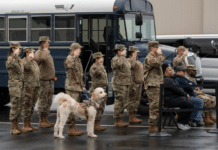ClearanceJobs – Eventually, all service members have to get out of the military. It is an inevitable change that if not done properly, can have a profound effect on your life. And yes, there are branch-based Transition Assistance Programs (TAP), but they only go so far.
To be best prepared at the time it happens, start preparing for your transition shortly after enlisting. While that may sound extreme, it is the best course of action so that you are the best prepared for departure.
Transitioning can be broken down into three different scenarios:
- After one tour
- After several tours
- At retirement
While much can be said about each scenario, we are just focusing on transitioning after one tour. This option usually leaves service members with three options; get a job, go to school, or continue serving differently.
Options After Just One Tour
Get a Job
If you pick getting a job, one of the first questions you need to consider first what you want out of that first job. Do you just want something to pay the bills while you decide your next move, like selecting a career path or going to school? Or are you going to start your career right away?
If you used Tuition Assistance while serving, or earned your degree before going in, you may already meet the education requirement of your chosen field.After you figure out your why for the first job, your next logical step is to begin working on becoming as competitive as possible.
After being out of the civilian marketplace (or maybe not ever having been there in the first place if you enlisted right out of high school), your competitiveness might range from non-existent to being a little rusty.
If you are unsure of what you want to do, take a personality or behavioral assessment test to help determine where your skills and interests lie and how they match up with open positions. Keep in mind that if you have a valid security clearance, it can open up more job opportunities and at a higher salary.
Once you know what you want to do, next comes getting those skills, interests, and military experience and training down on paper in the form of a resume. It is this step that trips up many veterans as they have trouble translating military job descriptions, jargon and acronyms into language that non-military hiring managers can understand. It is not as much of a problem if you are applying for jobs with a defense contractor, as they are usually familiar with the military lingo.
One technique that works well is to ask veterans that went before you into the civilian workplace if you can have a copy of their resume to use as a guide. This is one example where networking with other veterans can be worth its weight in gold.
Or you can hire a professional military-to-civilian resume preparer that is trained on how to best wordsmith your information into a resume. Finally, start working on your interviewing skills, so that you are ready when you get the first opportunity.
Go To School
You might want to start (or continue) working on your post-secondary education. This usually begins with choosing a career field first, so you can choose the right degree or training program to support that choice. Next is determining if your program is offered both online and on-campus, or just on campus.
Many veterans like to go to school online because of the flexibility of learning and because it fits better into their life schedule. Most of them have other responsibilities to consider (like a spouse, children, or a job) and they can’t afford the luxury of the time spent commuting back and forth and attending classes on campus at set times.
Keep in mind that if using the Post 9/11 GI Bill, the monthly housing allowance (MHA) amount for online-only classes is about half of what it is if attending hybrid or on-campus classes.
After you figure out your preferred classroom venue, then start looking for a school. To narrow the field of your potential school choices, use a school finder or the GI Bill Comparison Tool.
All content herein is owned by author exclusively. Expressed opinions are NOT necessarily the views of VNR, authors, affiliates, advertisers, sponsors, partners, technicians, or VT Network. Some content may be satirical in nature.
All images within are full responsibility of the author and NOT VNR.
Read Full Policy Notice - Comment Policy
































